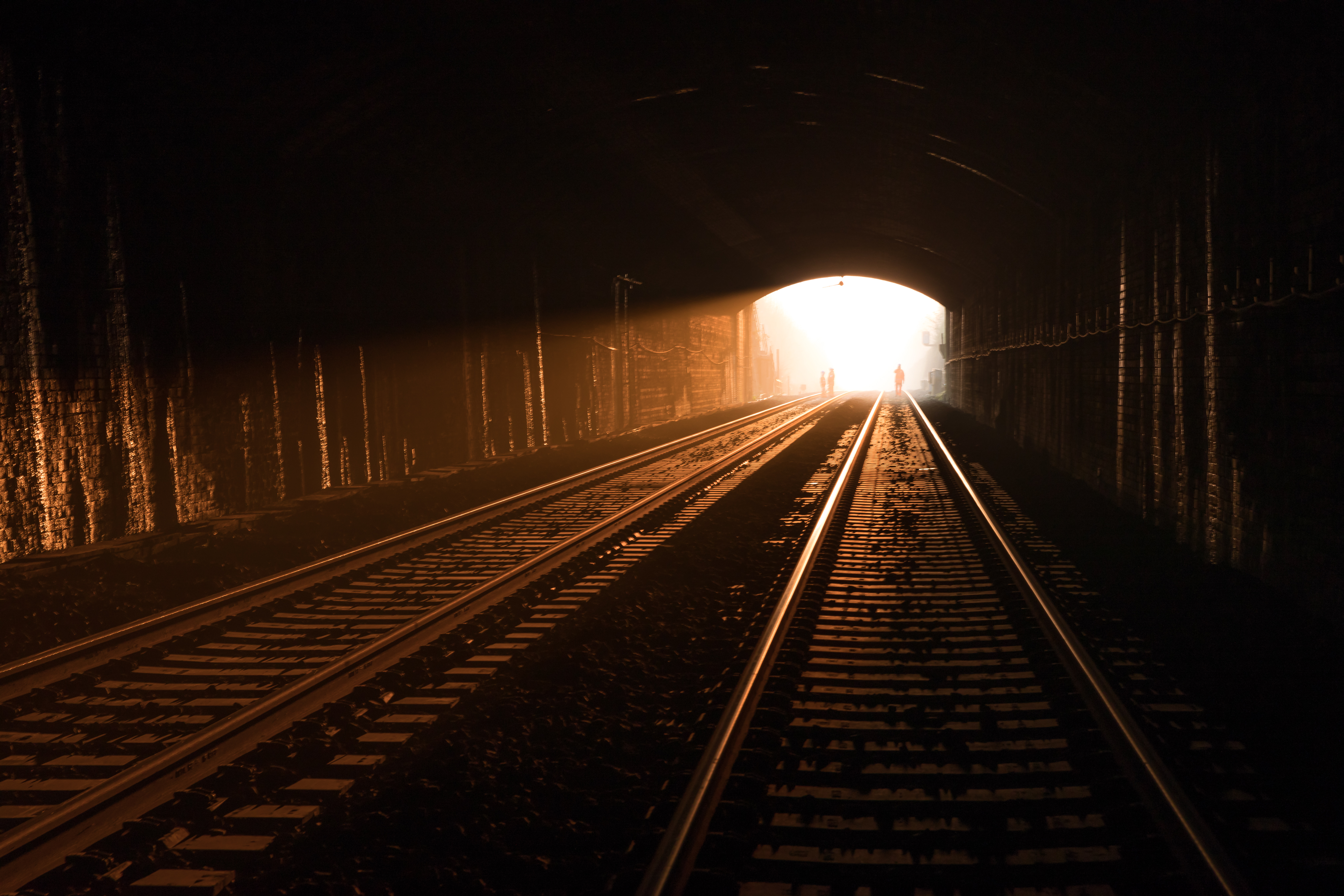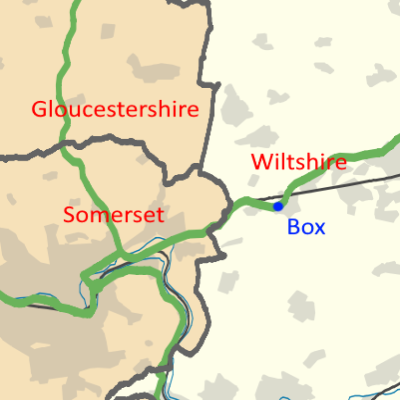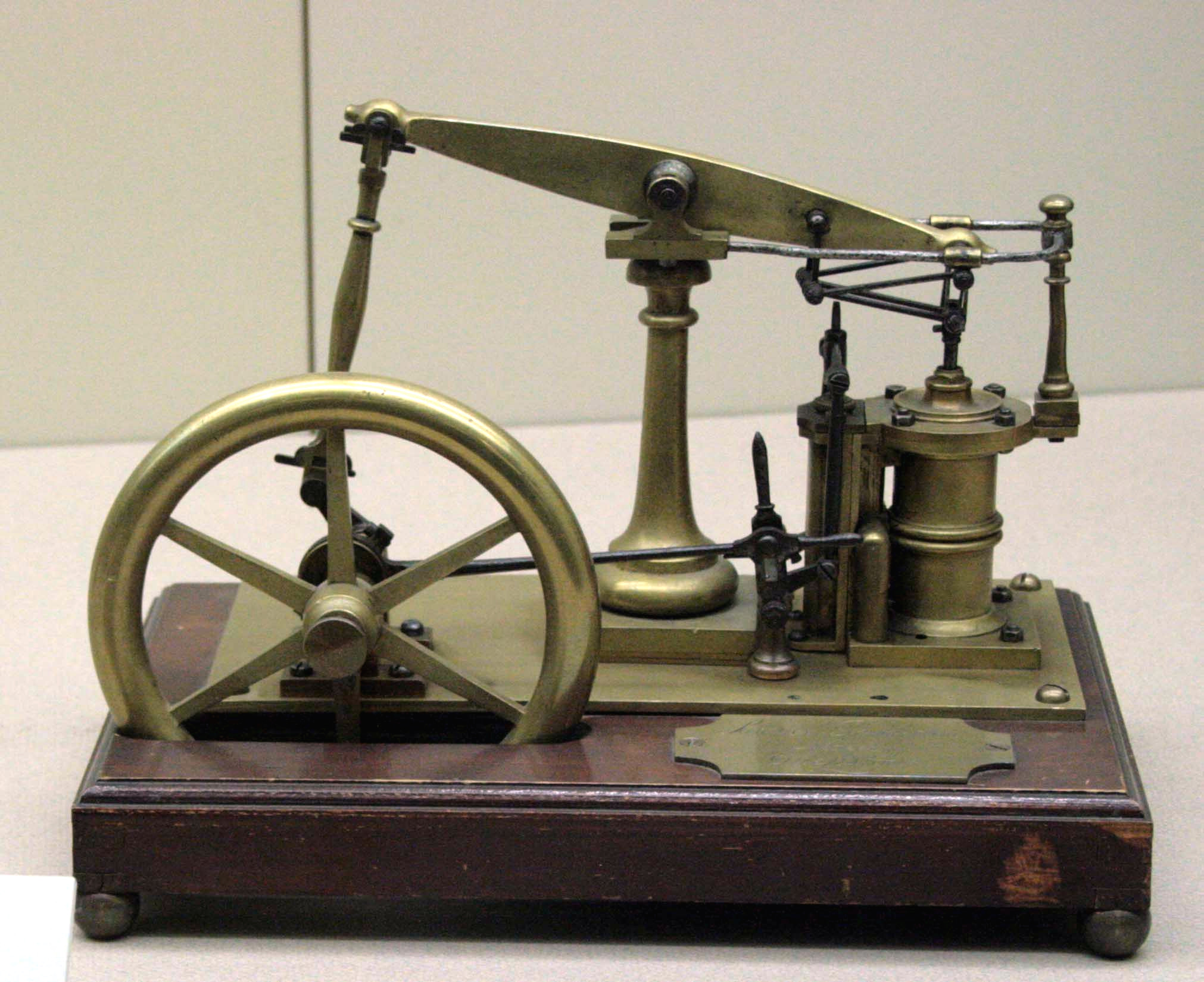|
Box Tunnel
Box Tunnel passes through Box Hill on the Great Western Main Line (GWML) between Bath and Chippenham. The tunnel was the world's longest railway tunnel when it was completed in 1841. Built between December 1838 and June 1841 for the Great Western Railway (GWR) under the direction of Isambard Kingdom Brunel, the straight tunnel descends on a 1 in 100 gradient from its eastern end. At the time the tunnel's construction was considered dangerous due to its length and the composition of the underlying strata. The west portal is Grade II* listed and the east portal is Grade II listed. Ammunition was stored near the tunnel during World War II, reusing mine workings. During the 2010s, the tunnel was modified and the track lowered to prepare it for electrification, although in 2016, this plan has been suspended for the time being. History Background During the 1830s, Isambard Kingdom Brunel developed a plan for a railway running east–west between London and Bristol. The Great Weste ... [...More Info...] [...Related Items...] OR: [Wikipedia] [Google] [Baidu] |
Great Western Main Line
The Great Western Main Line (GWML) is a main line railway in England that runs between London Paddington and . It connects to other main lines such as those from Reading to Penzance and Swindon to Swansea. The GWML is presently a part of the national rail system managed by Network Rail, while the majority of passenger services upon it are provided by the current Great Western Railway franchise. The GWML was built by the original Great Western Railway company between 1838 and 1841, as a dual track line in the broad gauge. The broad gauge remained in use until 1892, after which standard gauge track has been exclusively used. Between 1877 and 1932, many sections of the GWML were widened to four tracks. During 1908, Automatic Train Control (ATC) was introduced as a safety measure. In 1948, the Great Western Railway, and thus the GWML, was merged into the Western Region of British Railways. During the 1970s, the GWML was upgraded to support higher line speeds, as a result o ... [...More Info...] [...Related Items...] OR: [Wikipedia] [Google] [Baidu] |
Bath Stone
Bath Stone is an oolitic limestone comprising granular fragments of calcium carbonate originally obtained from the Middle Jurassic aged Great Oolite Group of the Combe Down and Bathampton Down Mines under Combe Down, Somerset, England. Its honey colouring gives the World Heritage City of Bath, England, its distinctive appearance. An important feature of Bath Stone is that it is a ' freestone', so-called because it can be sawn or 'squared up' in any direction, unlike other rocks such as slate, which form distinct layers. Bath Stone has been used extensively as a building material throughout southern England, for churches, houses, and public buildings such as railway stations. Some quarries are still in use, but the majority have been converted to other purposes or are being filled in. Geological formation Bath Stone is an oolitic limestone comprising granular fragments of calcium carbonate laid down during the Jurassic Period (195 to 135 million years ago) when the regio ... [...More Info...] [...Related Items...] OR: [Wikipedia] [Google] [Baidu] |
A4 Road (England)
The A4 is a major road in England from Central London to Avonmouth via Heathrow Airport, Reading, Berkshire, Reading, Bath, Somerset, Bath and Bristol. It is historically known as the Bath Road with newer sections including the Great West Road and Portway, Bristol, Portway. The road was once the main route from London to Bath, Bristol and the west of England and formed, after the A40 road, A40, the second main western artery from London. Although most traffic is carried by the M4 motorway today, the A4 still acts as the main route from Bristol to London for non-motorway traffic. History Turnpikes The A4 has gone through many transformations through the ages from pre-Roman routes, Roman roads (such as Roman road from Silchester to Bath, the one passing Silbury Hill), and basic wagon tracks. During the Middle Ages, most byways and tracks served to connect villages with their nearest market town. A survey of Savernake Forest near Hungerford in 1228 mentions "The King's Street" r ... [...More Info...] [...Related Items...] OR: [Wikipedia] [Google] [Baidu] |
Classical Architecture
Classical architecture typically refers to architecture consciously derived from the principles of Ancient Greek architecture, Greek and Ancient Roman architecture, Roman architecture of classical antiquity, or more specifically, from ''De architectura'' (c. 10 AD) by the Roman architect Vitruvius. Variations of classical architecture have arguably existed since the Carolingian Renaissance, and became especially prominent during the Italian Renaissance and the later period known as neoclassical architecture or Classical revival. While classical styles of architecture can vary, they generally share a common "vocabulary" of decorative and structural elements. Across much of the Western world, classical architectural styles have dominated the history of architecture from the Renaissance until World War II. Classical architecture continues to influence contemporary architects. The term ''classical architecture'' can also refer to any architectural tradition that has evolved to a highl ... [...More Info...] [...Related Items...] OR: [Wikipedia] [Google] [Baidu] |
Box, Wiltshire
Box is a large village and Civil parishes in England, civil parish within the Cotswolds Area of Outstanding Natural Beauty in Wiltshire, England, about west of Corsham and northeast of Bath, Somerset, Bath. Box also falls in the easternmost part of the Avon Green Belt. Besides the village of Box, the parish includes the villages of Ashley, Wiltshire, Ashley and Box Hill, Wiltshire, Box Hill; Hazelbury Manor, Hazelbury manor; and the hamlets of Alcombe, Blue Vein, Chapel Plaister, Ditteridge, Henley, Kingsdown, Box, Kingsdown, Middlehill, and Wadswick. To the east the parish includes much of Rudloe, formerly a hamlet but now a housing estate, and the defence establishments and related businesses on the site of the former RAF Rudloe Manor. Occupation here dates back at least to Roman Britain, Roman times. The area is known for its fine stone, and for centuries Box quarries were famous for their product. Today Box is perhaps better known for its Isambard Kingdom Brunel, Brunel-des ... [...More Info...] [...Related Items...] OR: [Wikipedia] [Google] [Baidu] |
Bristol Temple Meads Railway Station
Bristol Temple Meads is the oldest and largest railway station in Bristol, England. It is located away from London Paddington. It is an important transport hub for public transport in the city; there are bus services to many parts of the city and surrounding districts, with a ferry to the city centre. It is the busiest station in South West England, and the fifth busiest in Southern England outside of London. Bristol's other major station, Bristol Parkway, is a more recent station on the northern outskirts of the conurbation. Temple Meads was opened on 31 August 1840, as the western terminus of the Great Western Railway. The railway, including Temple Meads, was the first to be designed by the British engineer Isambard Kingdom Brunel. Soon, the station was also used by the Bristol and Exeter Railway, the Bristol and Gloucester Railway, the Bristol Harbour Railway and the Bristol and South Wales Union Railway. To accommodate the increasing number of trains, the station was exp ... [...More Info...] [...Related Items...] OR: [Wikipedia] [Google] [Baidu] |
Broad-gauge
A broad-gauge railway is a railway with a track gauge (the distance between the rails) broader than the used by standard-gauge railways. Broad gauge of , more known as Russian gauge, is the dominant track gauge in former Soviet Union countries ( CIS states, Baltic states, Georgia, Ukraine) and Mongolia. Broad gauge of , commonly known as five foot gauge, is mainly used in Finland. Broad gauge of , commonly known as Irish gauge, is the dominant track gauge in Ireland, the Australian state of Victoria and Adelaide in South Australia and passenger trains of Brazil. Broad gauge of , commonly known as Iberian gauge, is the dominant track gauge in Spain and Portugal. Broad gauge of , commonly known as Indian gauge, is the dominant track gauge in India, Pakistan, Bangladesh, Sri Lanka, Argentina, Chile, and on BART (Bay Area Rapid Transit) in the San Francisco Bay Area. This is the widest gauge in common use anywhere in the world. It is possible for trains on both Iberian gauge and ... [...More Info...] [...Related Items...] OR: [Wikipedia] [Google] [Baidu] |
Bath Spa Railway Station
Bath Spa railway station is the principal station serving the city of Bath, Somerset, Bath in Somerset, England. It is on the Great Western Main Line, down the line from the zero point at between to the east and to the west. It is the busiest station in Somerset, and the second busiest station in South West England after . The station is managed by Great Western Railway (train operating company), Great Western Railway, which operates all trains at this station. History Bath Spa station was built in 1840 for the Great Western Railway by Isambard Kingdom Brunel, Brunel and is now a Grade II* listed building. It is in an asymmetrical Tudor Revival architecture, Tudor style with curving gables on the north bank of the River Avon (Bristol), Avon where the line curves across from the southern bank to the station and then back again. Opened on 31 August 1840, the station was named ''Bath'' and was renamed ''Bath Spa'' in 1949 to distinguish it from station, which did not have i ... [...More Info...] [...Related Items...] OR: [Wikipedia] [Google] [Baidu] |
Navvy
Navvy, a Clipping (morphology), clipping of navigator (United Kingdom, UK) or navigational engineer (United States, US), is particularly applied to describe the manual Laborer, labourers working on major civil engineering projects and occasionally in North America to refer to mechanical shovels and earth moving machinery. The term was coined in the late 18th century in Kingdom of Great Britain, Great Britain when numerous canals were being built, which were also sometimes known as "navigations". Nationalities A study of 19th-century Rail transport in Great Britain, British railway contracts by David Brooke, coinciding with Census in the United Kingdom, census returns, showed that the great majority of navvies in Britain were English. He also stated that "only the ubiquitous Irish can be regarded as a truly international force in railway construction," but the Irish were only about 30% of the navvies. By 1818, high wages in North America attracted many Irish workers to become a ... [...More Info...] [...Related Items...] OR: [Wikipedia] [Google] [Baidu] |
Rock Blasting
Drilling and blasting is the controlled use of explosives and other methods, such as gas pressure blasting pyrotechnics, to break rock for excavation. It is practiced most often in mining, quarrying and civil engineering such as dam, tunnel or road construction. The result of rock blasting is often known as a rock cut. Drilling and blasting currently utilizes many different varieties of explosives with different compositions and performance properties. Higher velocity explosives are used for relatively hard rock in order to shatter and break the rock, while low velocity explosives are used in soft rocks to generate more gas pressure and a greater heaving effect. For instance, an early 20th-century blasting manual compared the effects of black powder to that of a wedge, and dynamite to that of a hammer. The most commonly used explosives in mining today are ANFO based blends due to lower cost than dynamite. Before the advent of tunnel boring machines (TBMs), drilling and b ... [...More Info...] [...Related Items...] OR: [Wikipedia] [Google] [Baidu] |
Steam Engine
A steam engine is a heat engine that performs Work (physics), mechanical work using steam as its working fluid. The steam engine uses the force produced by steam pressure to push a piston back and forth inside a Cylinder (locomotive), cylinder. This pushing force can be transformed by a connecting rod and Crank (mechanism), crank into rotational force for work. The term "steam engine" is most commonly applied to reciprocating engines as just described, although some authorities have also referred to the steam turbine and devices such as Hero's aeolipile as "steam engines". The essential feature of steam engines is that they are external combustion engines, where the working fluid is separated from the combustion products. The ideal thermodynamic cycle used to analyze this process is called the Rankine cycle. In general usage, the term ''steam engine'' can refer to either complete steam plants (including Boiler (power generation), boilers etc.), such as railway steam locomot ... [...More Info...] [...Related Items...] OR: [Wikipedia] [Google] [Baidu] |
Network Rail Virtual Archive Box Tunnel
Network, networking and networked may refer to: Science and technology * Network theory, the study of graphs as a representation of relations between discrete objects * Network science, an academic field that studies complex networks Mathematics * Networks, a graph with attributes studied in network theory ** Scale-free network, a network whose degree distribution follows a power law ** Small-world network, a mathematical graph in which most nodes are not neighbors, but have neighbors in common * Flow network, a directed graph where each edge has a capacity and each edge receives a flow Biology * Biological network, any network that applies to biological systems * Ecological network, a representation of interacting species in an ecosystem * Neural network, a network or circuit of neurons Technology and communication * Artificial neural network, a computing system inspired by animal brains * Broadcast network, radio stations, television stations, or other electronic media outlet ... [...More Info...] [...Related Items...] OR: [Wikipedia] [Google] [Baidu] |











